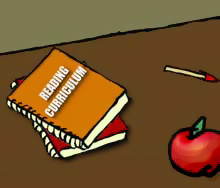How can teachers increase student reading success in early grades?
Page 3: High-Quality Instruction: Comprehensive Core Reading Program
 The second feature of high-quality instruction is a comprehensive core reading program. A comprehensive core reading program is the primary instructional tool that teachers use to implement effective reading instruction. Comprehensive core reading programs:
The second feature of high-quality instruction is a comprehensive core reading program. A comprehensive core reading program is the primary instructional tool that teachers use to implement effective reading instruction. Comprehensive core reading programs:
- Organize the scope and sequence of lessons in which specific skills are taught so that teachers don’t have to make it up as they go
- Create consistency across classrooms, grade levels, schools, and districts
- Provide research-validated materials and strategies for meeting diverse students’ needs
- Build curricula and instructional practices that support students’ initial learning as well as the transfer of knowledge and skills to other contexts
- Reflect state standards, which identify benchmarks and target instruction at each grade level
To help ensure high-quality instruction, all teachers are expected to use a school-adopted core program as the foundation for their reading instruction. Doing so supports students as they progress along the continuum from “learning to read” to “reading to learn.”
 Research demonstrates that reading skills improve when content is delivered reliably and methodically. Many comprehensive core reading programs provide instruction in a systematic and consistent manner. Furthermore, these programs promote students’ acquisition of the five critical components of reading.
Research demonstrates that reading skills improve when content is delivered reliably and methodically. Many comprehensive core reading programs provide instruction in a systematic and consistent manner. Furthermore, these programs promote students’ acquisition of the five critical components of reading.
The Five Critical Components of a Comprehensive Core Reading Program
For more than three decades, research has shown that acquiring adequate skills in five critical components of reading helps students to become good readers. These components are interconnected. The following table lists each component and the recommended grades in which to implement the instruction for each.
| Reading Component | Kindergarten | First Grade | Second Grade | Third Grade |
| Phonemic Awareness | ||||
| Phonics and Word Study | ||||
| Fluency | ||||
| Vocabulary | ||||
| Reading Comprehension |
National Reading Panel, 2000; Texas Essential Knowledge and Skills (TEKS)
Effective teachers use core reading programs as a basis for delivering the five components of reading instruction and, in doing so, help prevent students’ reading failure in the early grades. Such reading instruction, however, requires a solid understanding of the relevant skills as well as one of how the activities or assignments relate to those skills.
 Classroom teachers may wish to evaluate the current core reading program used in their schools, to determine whether the five components are being adequately addressed. The Consumer’s Guide to Evaluating a Core Reading Program is a tool to evaluate core reading programs and is available at no charge from the Institute for the Development of Educational Achievement, College of Education, University of Oregon. For more information about this guide, see Resource Page 13. Teachers can utilize this tool to help determine the strengths and weaknesses of their school’s core reading program. If a program’s analysis indicates that one or more components are weak, teachers should enrich the program through supplemental materials or instructional activities. When more than one teacher per grade level is using the same core reading program, it is imperative that teachers collaborate and share their experiences, including those about which materials and activities are effective and which ones are not.
Classroom teachers may wish to evaluate the current core reading program used in their schools, to determine whether the five components are being adequately addressed. The Consumer’s Guide to Evaluating a Core Reading Program is a tool to evaluate core reading programs and is available at no charge from the Institute for the Development of Educational Achievement, College of Education, University of Oregon. For more information about this guide, see Resource Page 13. Teachers can utilize this tool to help determine the strengths and weaknesses of their school’s core reading program. If a program’s analysis indicates that one or more components are weak, teachers should enrich the program through supplemental materials or instructional activities. When more than one teacher per grade level is using the same core reading program, it is imperative that teachers collaborate and share their experiences, including those about which materials and activities are effective and which ones are not.
The subsequent pages will address the specifics of these five components of high-quality reading instruction based on research findings.